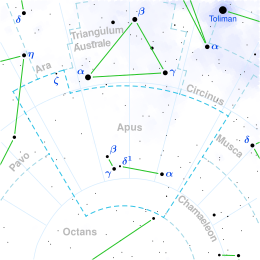Epsilon Apodis, Latinized from ε Apodis, is the Bayer designation for a star in the southern circumpolar constellation of Apus. It has an apparent visual magnitude of 5.06,[2] which is bright enough to be viewed from dark suburban skies. Based upon parallax measurements, it is at a distance of roughly 640 light-years (200 parsecs) from Earth.[1]

| Observation data Epoch J2000 Equinox J2000 | |
|---|---|
| Constellation | Apus |
| Right ascension | 14h 22m 23.16467s[1] |
| Declination | −80° 06′ 32.2053″[1] |
| Apparent magnitude (V) | 5.06[2] |
| Characteristics | |
| Spectral type | B3 V[3] |
| U−B color index | −0.610[2] |
| B−V color index | −0.121[2] |
| Variable type | γ Cas[4] |
| Astrometry | |
| Radial velocity (Rv) | +4.5[5] km/s |
| Proper motion (μ) | RA: −9.51[1] mas/yr Dec.: −14.34[1] mas/yr |
| Parallax (π) | 5.06 ± 0.22 mas[1] |
| Distance | 640 ± 30 ly (198 ± 9 pc) |
| Absolute magnitude (MV) | −1.41[6] |
| Details | |
| Mass | 6.15±0.71[7] M☉ |
| Radius | 3.9[8] R☉ |
| Luminosity | 1,614[7] L☉ |
| Surface gravity (log g) | 4.18[9] cgs |
| Temperature | 17,050[7] K |
| Metallicity [Fe/H] | −0.02[9] dex |
| Rotational velocity (v sin i) | 255[10] km/s |
| Age | 38.3±4.4[11] Myr |
| Other designations | |
| Database references | |
| SIMBAD | data |
Based upon a stellar classification of B3 V,[3] this is a massive, B-type main sequence star that is generating energy through the fusion of hydrogen at its core. Epsilon Apodis has more than six[7] times the mass of the Sun and nearly four[8] times the Sun's radius. It is radiating 1,614[7] times as much luminosity as the Sun from its outer envelope at an effective temperature of 17,050 K.[7] At this heat, it has a blue-white glow that is a characteristic of B-type stars.[14]
It is spinning rapidly, with a projected rotational velocity of 255 km/s[10] giving a lower bound for the azimuthal velocity along the equator. Epsilon Apodis is classified as a Gamma Cassiopeiae type[4] variable star and its brightness varies between magnitudes 4.99 and 5.04.[15]
Naming
In Chinese caused by adaptation of the European southern hemisphere constellations into the Chinese system, 異雀 (Yì Què), meaning Exotic Bird, refers to an asterism consisting of ε Apodis, ζ Apodis, ι Apodis, β Apodis, γ Apodis, δ Octantis, δ1 Apodis, η Apodis and α Apodis. Consequently, ε Apodis itself is known as 異雀九 (Yì Què jiǔ, English: the Ninth Star of Exotic Bird.)[16]
References
External links
Wikiwand in your browser!
Seamless Wikipedia browsing. On steroids.
Every time you click a link to Wikipedia, Wiktionary or Wikiquote in your browser's search results, it will show the modern Wikiwand interface.
Wikiwand extension is a five stars, simple, with minimum permission required to keep your browsing private, safe and transparent.

